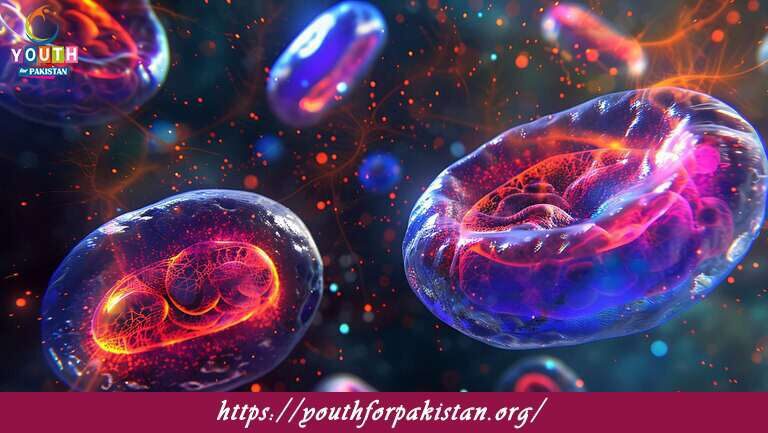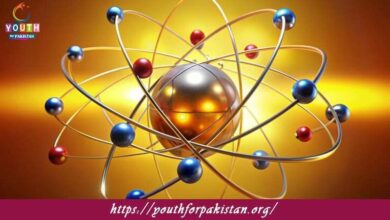11th Class Biology Chapter 2 MCQs with Answers

Delve into Biological Molecules MCQs that cover topics like carbohydrates, lipids, proteins, and nucleic acids. This quiz focuses on biomolecular structures, functions, and biochemical significance, helping you prepare for academic excellence. Ace Chapter 2 with these well-curated questions tailored for 11th Class Biology students.
Which type of biological molecule is the main source of energy for living organisms?
a) Proteins
b) Lipids
c) Carbohydrates
d) Nucleic acids
Enzymes, hormones, and antibodies are examples of which type of biological molecule?
a) Proteins
b) Lipids
c) Carbohydrates
d) Nucleic acids
Which of the following is not a monosaccharide?
a) Glucose
b) Fructose
c) Sucrose
d) Galactose
The building blocks of proteins are:
a) Fatty acids
b) Monosaccharides
c) Amino acids
d) Nucleotides
Which type of biological molecule forms the structural framework of cells and tissues?
a) Proteins
b) Lipids
c) Carbohydrates
d) Nucleic acids
The main function of nucleic acids is:
a) Energy storage
b) Catalyzing chemical reactions
c) Transmitting genetic information
d) Providing insulation
Which type of lipid is commonly known as fats and oils?
a) Phospholipids
b) Steroids
c) Triglycerides
d) Waxes
The two main types of nucleic acids are:
a) DNA and RNA
b) Glucose and fructose
c) Starch and cellulose
d) Saturated and unsaturated fats
The primary function of carbohydrates in living organisms is to:
a) Provide energy
b) Act as enzymes
c) Form cell membranes
d) Store genetic information
The storage form of glucose in animals is called:
a) Starch
b) Glycogen
c) Cellulose
d) Chitin
Which of the following is a complex carbohydrate that forms the structural component of plant cell walls?
a) Starch
b) Glycogen
c) Cellulose
d) Chitin
The building blocks of nucleic acids are:
a) Fatty acids
b) Monosaccharides
c) Amino acids
d) Nucleotides
The sugar component in DNA is:
a) Glucose
b) Ribose
c) Deoxyribose
d) Galactose
The sugar component in RNA is:
a) Glucose
b) Ribose
c) Deoxyribose
d) Galactose
Which type of lipid forms the main component of cell membranes?
a) Phospholipids
b) Steroids
c) Triglycerides
d) Waxes
Which of the following is not a function of proteins in living organisms?
a) Catalyzing chemical reactions
b) Providing structural support
c) Storing genetic information
d) Transporting substances in the blood
The long chains of amino acids in a protein are linked together by:
a) Disulfide bonds
b) Ionic bonds
c) Hydrogen bonds
d) Peptide bonds
Which of the following is a function of lipids in living organisms?
a) Providing quick energy
b) Catalyzing chemical reactions
c) Forming cell walls
d) Insulating the body
The genetic information in living organisms is stored in the form of:
a) Carbohydrates
b) Proteins
c) Nucleic acids
d) Lipids
The storage form of glucose in plants is called:
a) Starch
b) Glycogen
c) Cellulose
d) Chitin
Which type of lipid is important for the formation of hormones and cell membranes?
a) Phospholipids
b) Steroids
c) Triglycerides
d) Waxes
The process by which two molecules are joined together with the removal of a water molecule is called:
a) Hydrolysis
b) Dehydration synthesis
c) Oxidation
d) Reduction
The type of bond that forms between the amino acids in a protein is a:
a) Hydrogen bond
b) Ionic bond
c) Peptide bond
d) Disulfide bond
The process by which large molecules are broken down into smaller molecules with the addition of a water molecule is called:
a) Hydrolysis
b) Dehydration synthesis
c) Oxidation
d) Reduction
Which of the following is a function of carbohydrates in living organisms?
a) Providing structural support
b) Storing genetic information
c) Forming cell membranes
d) Transporting substances in the blood
Which of the following is not a function of nucleic acids in living organisms?
a) Transmitting genetic information
b) Catalyzing chemical reactions
c) Acting as energy storage molecules
d) Regulating gene expression
The type of lipid that forms a protective coating on the surface of leaves and stems is called:
a) Phospholipids
b) Steroids
c) Triglycerides
d) Waxes
The genetic material that carries the instructions for the synthesis of proteins in a cell is:
a) DNA
b) RNA
c) ATP
d) ADP
The type of lipid that forms a major component of cell membranes and has a hydrophilic head and hydrophobic tails is called:
a) Phospholipids
b) Steroids
c) Triglycerides
d) Waxes
The molecule that serves as the primary energy carrier in cells is:
a) DNA
b) RNA
c) ATP
d) ADP
The genetic material that is involved in protein synthesis and is directly responsible for translating genetic information into proteins is:
a) DNA
b) RNA
c) ATP
d) ADP
The molecule that is the primary energy currency of the cell and stores and transfers energy for cellular processes is:
a) DNA
b) RNA
c) ATP
d) ADP
The type of RNA that carries the genetic information from DNA to the ribosomes for protein synthesis is called:
a) mRNA
b) tRNA
c) rRNA
d) siRNA
The type of RNA that brings amino acids to the ribosomes during protein synthesis is called:
a) mRNA
b) tRNA
c) rRNA
d) siRNA
The type of RNA that makes up the ribosomes and is involved in protein synthesis is called:
a) mRNA
b) tRNA
c) rRNA
d) siRNA
The type of RNA that regulates gene expression and inhibits the translation of specific mRNAs is called:
a) mRNA
b) tRNA
c) rRNA
d) siRNA
Which of the following is not a characteristic of water molecules due to hydrogen bonding?
a) High surface tension
b) Low heat capacity
c) High boiling point
d) Adhesion to other surfaces
Which of the following is not a function of proteins in living organisms?
a) Catalyzing chemical reactions
b) Providing structural support
c) Storing genetic information
d) Transporting substances in the blood
Which of the following is a function of nucleic acids in living organisms?
a) Transmitting genetic information
b) Catalyzing chemical reactions
c) Acting as energy storage molecules
d) Regulating gene expression
Which of the following is a polysaccharide?
a) Glucose
b) Fructose
c) Sucrose
d) Starch
The type of bond that forms between two water molecules due to their partial charges is called a:
a) Hydrogen bond
b) Ionic bond
c) Covalent bond
d) Peptide bond
Which of the following is a disaccharide?
a) Glucose
b) Fructose
c) Sucrose
d) Starch
The type of lipid that forms hormones such as testosterone and estrogen is called:
a) Phospholipids
b) Steroids
c) Triglycerides
d) Waxes
The type of bond that forms between two sulfur-containing amino acids in a protein is a:
a) Hydrogen bond
b) Ionic bond
c) Disulfide bond
d) Peptide bond
Which of the following is not a function of lipids in living organisms?
a) Providing quick energy
b) Catalyzing chemical reactions
c) Forming cell walls
d) Insulating the body
The process by which two molecules are joined together with the removal of a water molecule is called:
a) Hydrolysis
b) Dehydration synthesis
c) Oxidation
d) Reduction
The type of bond that forms between the amino acids in a protein is a:
a) Hydrogen bond
b) Ionic bond
c) Peptide bond
d) Disulfide bond
The process by which large molecules are broken down into smaller molecules with the addition of a water molecule is called:
a) Hydrolysis
b) Dehydration synthesis
c) Oxidation
d) Reduction
Which of the following is a function of carbohydrates in living organisms?
a) Providing structural support
b) Storing genetic information
c) Forming cell membranes
d) Transporting substances in the blood
Which of the following is not a function of nucleic acids in living organisms?
a) Transmitting genetic information
b) Catalyzing chemical reactions
c) Acting as energy storage molecules
d) Regulating gene expression
The type of lipid that forms a protective coating on the surface of leaves and stems is called:
a) Phospholipids
b) Steroids
c) Triglycerides
d) Waxes
The genetic material that carries the instructions for the synthesis of proteins in a cell is:
a) DNA
b) RNA
c) ATP
d) ADP
The type of lipid that forms a major component of cell membranes and has a hydrophilic head and hydrophobic tails is called:
a) Phospholipids
b) Steroids
c) Triglycerides
d) Waxes
The molecule that serves as the primary energy carrier in cells is:
a) DNA
b) RNA
c) ATP
d) ADP
The genetic material that is involved in protein synthesis and is directly responsible for translating genetic information into proteins is:
a) DNA
b) RNA
c) ATP
d) ADP
The molecule that is the primary energy currency of the cell and stores and transfers energy for cellular processes is:
a) DNA
b) RNA
c) ATP
d) ADP
The type of RNA that carries the genetic information from DNA to the ribosomes for protein synthesis is called:
a) mRNA
b) tRNA
c) rRNA
d) siRNA
The type of RNA that brings amino acids to the ribosomes during protein synthesis is called:
a) mRNA
b) tRNA
c) rRNA
d) siRNA
The type of RNA that makes up the ribosomes and is involved in protein synthesis is called:
a) mRNA
b) tRNA
c) rRNA
d) siRNA
The type of RNA that regulates gene expression and inhibits the translation of specific mRNAs is called:
a) mRNA
b) tRNA
c) rRNA
d) siRNA
If you are interested to enhance your knowledge regarding Physics, Chemistry, Biology, and Computer please click on the link of each category, you will be redirected to dedicated website for each category.





